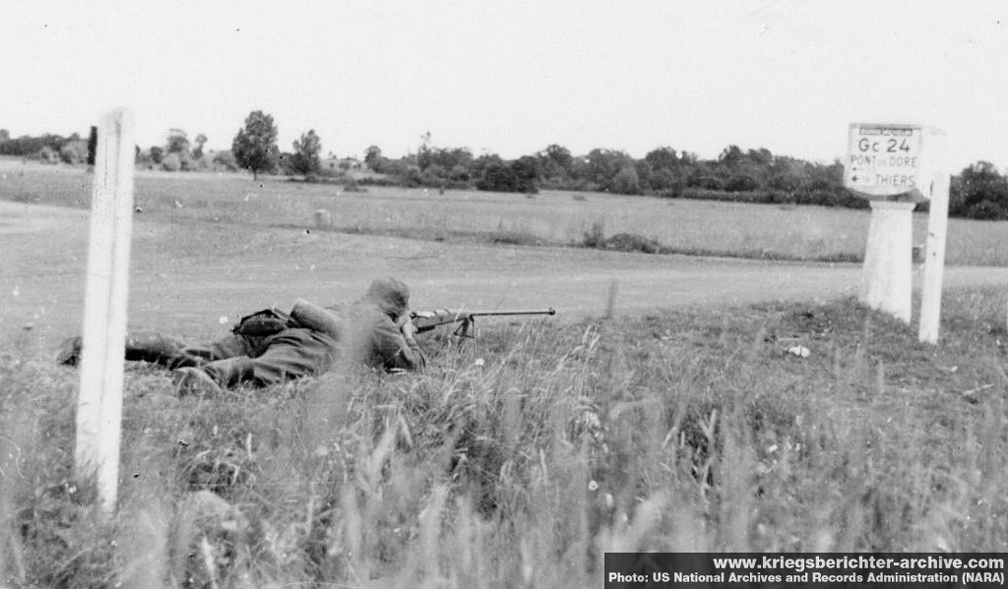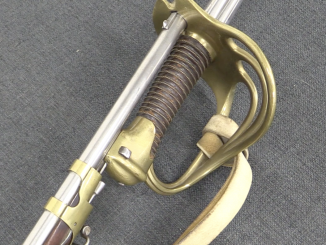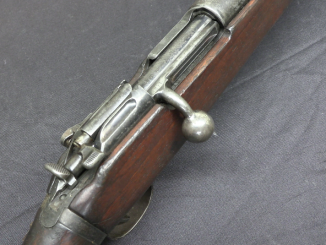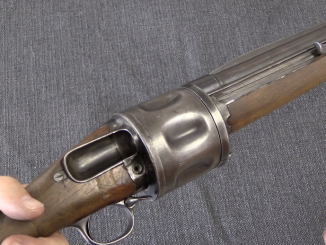
German soldier in France with a captured Polish Maroszek wz.35 anti-tank rifle.

German soldier in France with a captured Polish Maroszek wz.35 anti-tank rifle.

The Arcelin system was a capping breechloader provisionally adopted by the French military in 1854. It was a bolt action system with a folding bolt handle, firing a paper cartridge. It impressed Emperor Louis Napoleon […]

The German Wehrmacht was always hungry for more rifles during World War Two, and adopted substitute designs made in friendly (or subservient) countries when possible. Almost all of these were minor variations on the Mauser […]

The Becker shotgun is a very unusual blow-forward, revolving cylinder shotgun made in Germany in the 1920s (although it was originally patented in the late 1890s). Only a very small number were made – allegedly […]
© 2025 Forgotten Weapons.
Site developed by Cardinal Acres Web Development.

Very, very cool photo. I wonder if the wz 35 was effective against those weird looking French tanks?
I tend to doubt it, at least for the French mediums. They were both better armored and better armed than their German counterparts. Unfortunately, interior layout (dictated by current doctrine) was sub-optimal. The one man turrets imposed too heavy of a workload on commanders.
Most French tanks types were designed to fulfill “infantry tank” role, which mean low speed, but heavy armour (compare to British A11 Matilda tank). Most French Renault R35 tanks lacked radio equipment and where it was installed it additionally overloaded commander (in radio-equipped tank he must fulfill 4 roles: commander, loader, gunner, radio-operator). The lack of radio equipment mean that tanks units were hard to command in real combat.
That depended on which tanks the rifle encountered. It probably would smash most French light tanks, but I think the Char B1 would run this German over after having shot him with the 47mm turret gun and blasted his friends with the hull-mounted 75mm howitzer. Never take on the “heavy assault tank” with anything less powerful than a heavy field gun or the 8.8cm Flak 18…
Would you guys rather have the heavy MG 18 TuF chambered in 13.2mm T-gewehr?
No, the Type 92 Battalion gun with hollow charge rounds.
Okay, Chris, but I’m sure the Japanese crew wasn’t expecting a Sherman tank… But that Sherman had better watch out for the Type 88 heavy AA.
“It probably would smash most French light tanks”
Even the French light tanks like Hotchkiss H35, Renault R35, FCM36 were heavy armed: its armour thickness reach 40mm.
Guys this is Ur wz. 35 not “Maroszek”!
Józef Maroszek was designer of this gun, official name was “Karabin przeciwpancerny wz. 35” meaning anti-tank rifle model 1935. Name “Ur” become from “Uruguay” and it was supposed to confuse enemy intelligence suggesting that this is rifle for export to Uruguay.
They didn’t even admit that it was a rifle. The official contracts, and the shipping crate stenciling, all referred to it as “surveillance equipment”.
cheers
eon
glad vintage Saturday is back, missed them. keep em coming!
Same here! I kept hoping they’d come back!
“Conquering France with Polish guns”
Before the Barbarossa have captured guns, trucks and other equipment from various countries: Austria(denoted by ö in Fremden Gerät lists), Czechoslovakia (t), Poland (p), Denmark (d) and other). Supplying proper ammo and parts must be nightmare.
You said it. Germany was still recovering from Versailles Treaty whiplash, so the Wehrmacht had to do with what it had, both domestic and foreign. In fact, it was still using literal horsepower (and mule-power) most of the time for towing supply wagons and artillery even during Barbarossa, if I’m not mistaken.
Many years ago (like 30-35) I read memoirs of a German officer, who was an S-4 (logistics guy) of an infantry division in Barbarossa – unfortunately over the years I have forgotten the name of the author. “Nightmare” doesn’t even begin to describe his lot. His was a lowly foot-slogging infantry division, not some propaganda-darlings, and so they ended up with all the trash taken up during the early stage of expansion and then the war. He had Austrian, Czech, French, Belgian, British, Soviet and German trucks and cars, part gas, part diesel, 6V, 12V and 24 Volt electric systems, ca. 100 different types and sizes of just tires – and then on top of that the mechanical spares to keep that whole herd running. The only thing that was universal was the Motorenoel der Wehrmacht, which they did pour into each of these.
Now for the Ur vs Maroszek – both names are wrong, the regulation designation was “7,9 mm karabin wz. 35” or 7.9 mm Model of 1935 Rifle, with no hint at it being an ATR at all. The Uruguay or Ur was just a camouflage cover name used in correspondence between the manufacturer and the Military Affairs Ministry, never used in the service. The manual listed just the Rifle M35 moniker. And the designer was Józef Maroszek, the same guy who just two years later designed the wz.38M selfloading rifle for the Polish Army. These were considered secret weapns, and only in April 1939 the units started to train selected marksmen in their use. Several hundred were captured and were used in French campaign, because the PzB 38s and 39s were not available in enough numbers to fill the ranks. As to their efficiency – if they would be inefficient at all, nobody would bother to haul them, even in German army. There are many lightly armored targets that the ATR was perfectly capable of piercing, the Char B1 bis was not one of these. Afterwards, over 600 of the Polish rifles were sold to the Italians, along with newly-made German ammunition.
And mentioning all those vehicles of various origin, I would wager, from my experience with Lucas components, that about half those British vehicles would be negative-grounded electrical systems and the others would be positive-grounded. …Shocking!
Not to mention that British vehicles were build for left-hand traffic.
And so were Czech and Italian – the Swedes kept the left-hand driving until 1960s.
Japan is still left hand driving, as well as India, Australia and many other parts of the former British Empire.
When I was stationed in Connecticut in the late 70s I was going through my motorcycle phase – one of the shaggy civilians I rode with had a great story about being on the beach up in Rhode Island and meeting a cute little hippie chick whose vintage 6-volt Volkswagon had a dead battery. Since he was riding his lovingly restored 6-volt Harley knucklehead he offered her a jump… not realizing that the two vehicles had opposite grounds. A shocking experience, indeed!
Indeed. The wz.35 couldn’t have breached the armor of the Matilda, but it could have holed a Bren Carrier without a problem and that ability would be enough to warrant having them. The French also used tracked infantry carriers and the wz.35 could have taken them out as well. In both cases, disabling infantry carriers would have separated the Allied tanks and infantry, which is usually some the Germans sought to do.
Also, remember that many of the French tanks designated for infantry support in 1940 were still old FT-17s, and the wz.35 would also have been effective against them.
The FT-17ss, while still nominally in service, did not see much use in 1940. The French did not even have trained crews for most of them. They had a fairly large number of more modern light tanks, which unfortunately had some shortcomings already mentioned here.
The best “German” tank in the Battle of France was the Pzkpfw-38(t).
I would rather say that it was Panzer III (version with 5cm KwK 38 L/42 gun), as it feature good torsion-bars suspension.
Interesting comparison.
German tank was about twice as heavy as Czech, yet the former had lot thinner armour.
http://en.wikipedia.org/wiki/Panzer_III
http://en.wikipedia.org/wiki/Panzer_35(t)
Crew was 5 and 4 respectively.
I recall roaming thru one German tank in early part of my life (not sure if it was Pzkw II or III) but recall it was really spacious and yes, armour was laughably thin.
Wait we were discussing Panzer 38(t) not Panzer 35(t). Also armour thickness varied depending on version (Ausführung abbreviated Ausf.).
Panzer 38(t) Ausf. A to Ausf. D have maximum armour thickness 25mm
Panzer 38(t) Ausf. F to Ausf. G 50mm (but only frontally)
Panzer III Ausf. A to Ausf. C have 15mm all-around armour, but only very small amount of this vehicles was build (A: 10, B: 15, C: 15)
Panzer III Ausf. E, Ausf. F and Ausf.G have 30mm all-around armour
I think that within the scope of the French campaign, the Pz 38(t) and Pz III were practically equal. Both were mechanically reliable (more so than any later German WW2 tank, by the way) and quite fast by the standards of 1940, but also somewhat under-armored and under-armed compared to the French tanks and AT guns. The Pz III was bigger and had a lot more development potential as a tank, but the Pz 38(t) chassis was good enough that it continued to be used until the end of the war (e.g. the Hetzer tank destroyer). The Germans even designed an improved version of it called Pz 38(d) (d for Deutsch; i.e. German), which was to be used as the basis of many light armored vehicles in 1945.
I wonder why some enterprising instructor at the sniper school didn’t look at those rifles and think, “Hmm…maybe we could put a high-powered scope on one of these…” IIRC the U.S. didn’t start experimenting with the concept until embroiled in Korea by using captured PTRDs fitted with .50 M2 barrels and Unertl target scopes. I would think that the lack of tank-killing ability of these and the PzB 38/39s combined with the super-hot 7.92mm loads would have made this an obvious conversion. Such a weapon would have been quite useful for keeping the enemy at a distance.
“They couldn’t hit an elephant at this distance!” Guess who said this?
Supposing this rifle were adapted for mounting in an armored car turret, could it sneak close to an enemy base and shoot tank crews before they were in the tanks?
After the Lahti ATR had became obsolescent as AT weapons in 1943, Finnish soldiers used it in various ways which are similar to modern “anti-materiel” rifles. HE and APHE rounds were “borrowed” from AA gun crews and used against bunkers and even exposed tank commanders. No scopes were available, but with a HE round even hitting close to the target was often sufficient. For example a tank commander could be killed or seriously wounded by just hitting the top of the tank turret. Against the hard steel surface even the relatively small 20mm HE bullet/shell could produce lethal fragmentation. More common in practice was sniping bunker firing ports. APHE rounds could often penetrate wooden bunkers before exploding and HE rounds could wound several soldiers if they managed to enter the bunker through the port.
The biggest hindrance to these “activities” was the fact that this kind of use was never officially condoned by the army and therefore HE or APHE rounds were not officially issued to Lahti ATR crews. Nevertheless, they must not have went unnoticed by post-war planners, since the Lahti ATRs were kept warehoused all the way to the late 1980s (although the official reason was possible anti-helicopter use).
According to an article in the 1987 Gun Digest, they US Army did experiment with scope-mounted Boys rifles, rechambered to 50 BMG, during WW2. Seems there were earlier experiments with a rechambered T-Gewehr after WW1 as well, and scope-mounted M2-HBs in the 1930s.
In the ’50s there were also experiments with captured PTRDs and PTRSes as sniper rifles.
Regarding AT rifles in armored cars, the British actually supplied Boys rifles was standard equipment on the Marmon- Herrington armored cars used in North Africa, but only for the usual purposes.
The British were also the only army in the.battle of France with fully mechanized transport.
Boys were also mounted on Bren carriers.
Good job, Ian,
Andrzej
@Ian – some things never change in any army: give the 5’4″ 17 year old the machinegun, in this case an LMG 08/15!
http://i58.photobucket.com/albums/g264/ossoperative/German%20Naval%20Infantry/GermanNavalInfantryDenmark1.jpg
German Naval inf in Denmark